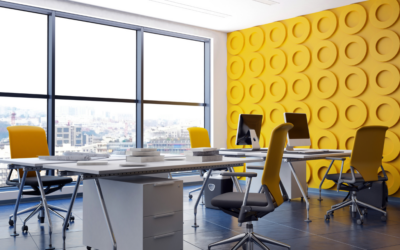The color scheme of your business plays a pivotal role in shaping its identity and influencing customer perceptions. Whether you’re revamping your office space, launching a new storefront, or rebranding your business, selecting the right paint color scheme is a crucial decision. In this guide, we’ll explore the key considerations and tips to help you make informed choices that align with your brand and create a welcoming atmosphere for clients and employees alike.
1. Understanding Color Theory
Color plays a huge role in how we understand the world around us and influences our choices, thoughts, and interactions. Think about it…we consider color when picking out our outfits for the day and we associate it with our favorite brands. Research shows that certain shades have the power to energize, rejuvenate, and even increase appetite.
So when it comes to business, all design choices should be made not only through stylistic preference but also through the understanding that designing with color can drive certain behaviors.
Red
- Red is a vibrant high-wavelength color that can be used to energize and boost motivation, drawing our attention and demonstrating a sense of urgency. Beware, overusing red, however, can make it difficult to concentrate after prolonged exposure. So use it sparingly or use it in lower-traffic areas.
Orange & Yellow
- One of the more commonly used colors for office spaces, shades of orange and yellow can help boost innovation and creativity and are most often linked to feelings of optimism and confidence.
Blue & Purple
- These are low-wavelength colors and are office design favorites since they lend a sense of well-being and are known to improve efficiency and focus. Shades of blue promote thinking, creativity, and performance within employees while helping to maintain a tranquil environment, making it a great option for conference rooms.
Green
- This is another low-wavelength color known to help with focus, but green also helps bridge the gap between nature and the built environment. Implemented through living walls, wall paint or furniture, green will harness mother nature’s undeniable psychological benefits for employees and visitors. Green is known to lower blood pressure and heart rate, give a heightened sense of creativity and improve productivity.
Neutrals
- Neutrals are shades of white, brown, gray, and black. They are often used to complement other colors and create depth and bring a sense of comfort and cleanliness to a space. While a color scheme of neutrals may have a modern appeal, when overdone they may cause employees to become distracted and bored.
2. Define Your Brand Personality
Before diving into a sea of color options, take a moment to define your brand personality. Consider the values, mission, and personality traits your business wants to convey. Is your brand modern and edgy, traditional and reliable, or perhaps vibrant and energetic? Your chosen colors should reflect these characteristics.
3. Consider Your Industry
Different industries have varying norms and expectations when it comes to color schemes. For example, a law firm might opt for more subdued and professional colors, while a creative agency may embrace bold and vibrant hues. Research color trends within your industry to strike a balance between standing out and fitting in.
4. Think About Functionality
The functionality of your space should influence your color choices. If your business involves a lot of creative thinking, consider using stimulating colors in collaborative areas. For a more focused environment, opt for calming and neutral tones. Think about how different colors may impact productivity and the overall atmosphere.
5. Consider the Architecture
The architectural elements of your space can influence the choice of colors. Consider the existing materials, lighting conditions, and layout of your space. Choose colors that enhance these elements rather than clash with them. Pay attention to how natural and artificial light interacts with the colors you’re considering.
6. Test Samples in Your Space
Colors can look different depending on lighting and surroundings. Always test paint samples directly on the walls in your space. This allows you to see how the colors will appear in the specific lighting conditions of your business environment.
7. Create a Cohesive Palette
A cohesive color palette creates a unified and polished look. Choose a primary color as the dominant hue, a secondary color to support and complement, and an accent color for highlights. This creates a visually appealing and balanced scheme that ties your branding together.
Understanding your business’s culture and how you want to shape it with workplace design is the first step in identifying and implementing a color scheme. With a basic knowledge of color psychology, employers can design an environment that tells the story of their unique brand. The professionals at Modern Painting have the knowledge and skill to not only help you find the perfect color palette but to ensure your business is painted in a timely manner, with little disruption to your customers. Give us a call. Quotes are free.
More article like this one…
Unveiling the Vibrant Palette: Commercial Paint Color Trends of 2024
As we step into 2024, the canvas of commercial spaces is being infused with a burst of color,...
The Challenges of Choosing a Painting Company for Your Business
Once you’ve decided your business needs a fresh coat of paint, it’s not as simple as choosing the...
Choosing the right commercial office colors can make a huge impact.
Suppose you’re thinking about repainting your commercial office space. In that case, you’ve...



